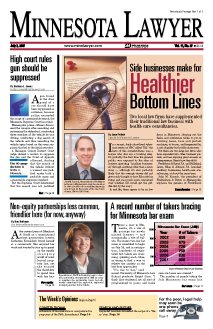
Malamud may be best known for pushing the federal government in the mid-1990s to put corporate filings and patent documents online at no cost. Now, he’s try to get the courts to do the same.
Our blog has moved, and is new and improved.
You should be automatically redirected in 3 seconds. If not, visit
MinnLawyerBlog.com
and update your bookmarks.
If it's legal, you can discuss it here

Any thoughts?One of the ironies of the judicial selection debate is that the argument is taking place before the Legislature rather than before a neutral factfinder. Here is what I would say if I were defending the present system in court:
Thank you, your Honor, for letting me defend the present system. I would ask you to dismiss the case against my client on the following grounds:
Standing: Petitioners claim to be representing the people when Petitioners are actually representing the Governor, who is not part of this lawsuit. Petitioners have failed to plead any just causes of action on behalf of the Governor. We do not know if the Governor wants the relief his counsel is requesting.
Ripeness: Even if Petitioners prevail on the standing issue, this case is not ripe. As there is no present or past harm, Petitioners’ only form of relief is an injunctive relief. To prevail, Petitioners need to prove an irreparable future harm. Given that judges have been elected in Minnesota for 150 years, Petitioners claim of immediate, irreparable harm cannot succeed.Summary Judgment: The standard of proof in a case in which the Constitution is challenged is that the challenging party must prove, beyond a reasonable doubt, that the Constitution should not be upheld.
Petitioners have not presented sufficient evidence to satisfy their burden. The fact that the trial judges have articulated a position that the proposed new system is worse than Petitioners’ proposed system is sufficient, by itself, to defeat Petitioners’ claims.
The court should summarily dismiss Petitioners’ claims. Petitioners’ claims are based entirely upon their belief that if judges are permitted to have free speech, judges will sacrifice people’s constitutional rights. Petitioners have presented no evidence that appointed judges are better judges than elected judges.
Your Honor, Petitioners’ many counsels are far from unanimous in their requested relief. The Quie Commission had three separate opinions, two of which were fairly divided. The Minnesota State Bar Association had a different system, and the judges have not adopted the MSBA’s position. This is in spite of the fact that, prior to today’s hearing, democracy has never had a hearing nor a chance to plead its case.
Lastly, protection of constitutional rights is not the sole responsibility of the judicial branch. If the courts are forced to declare laws unconstitutional, it is only because the legislative branch has passed an unconstitutional law and the executive branch is enforcing it. If changes are needed, the legislative and executive branches must begin to accept responsibility for protecting people’s rights.
Your Honor, I ask that you decide the case on the principles of law that govern any of your other decisions. At this time, Petitioners’ claims fail for numerous and weighty reasons.
Thank you, your Honor.Contrary to what the Chief Justice says, now is not the time to be united. Now is not the time for “heavy hitters” to plead their case before the Legislature. Now is the time for zealous advocacy on all sides before a neutral factfinder. Let’s have this debate in the judiciary -- the only branch of our government dedicated to fact finding.
-- David L. Ludescher, Northfield
 A San Francisco-based legal writer and editor has a blog that -- along with writing tips -- features the tortured attempts at the written word that are perpetrated on a regular basis not only by lawyers, but also by their law firm employers.
A San Francisco-based legal writer and editor has a blog that -- along with writing tips -- features the tortured attempts at the written word that are perpetrated on a regular basis not only by lawyers, but also by their law firm employers. The Minnesota Supreme Court is currently considering whether to allow cameras in the courtroom, and some trial judges are concerned. Are they worried about Jimmy Olsen coming in and snapping a picture for the Daily Planet? Hardly. A Mike Wallace wannabe kicking in the courtroom door with TV lights blazing? Not even close. No, it's the pernicious blogger who has struck fear deep into the hearts of some of the state's judiciary.
The Minnesota Supreme Court is currently considering whether to allow cameras in the courtroom, and some trial judges are concerned. Are they worried about Jimmy Olsen coming in and snapping a picture for the Daily Planet? Hardly. A Mike Wallace wannabe kicking in the courtroom door with TV lights blazing? Not even close. No, it's the pernicious blogger who has struck fear deep into the hearts of some of the state's judiciary.